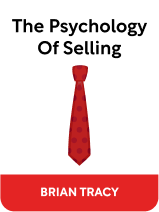

This article is an excerpt from the Shortform book guide to "The Psychology Of Selling" by Brian Tracy. Shortform has the world's best summaries and analyses of books you should be reading.
Like this article? Sign up for a free trial here .
Do you want to level up your prospecting game? What are some things you can do to increase your chances of converting a prospect into a customer?
Asking a prospective customer for an appointment is probably the most stressful and least-liked aspect of selling, and it’s the part that most often causes people to leave the profession. However, the good news is that prospecting is a skill and can be learned, practiced, and honed.
In this article, we’ll take a look at some prospecting tips that can make your cold calling more effective.
Prepare to Prospect
The first step in the selling process is getting an appointment. To do so, you’ll usually have to cold call: Call up strangers and get them to agree to meet with you so that you can show them your product or service.
Before making a phone call, mentally prepare so that you know exactly what you’re going to say, and you’re in the right frame of mind.
Plan every word of your opening statements to a potential customer. People make decisions quickly and on first impressions, and you only have about 30 seconds to convince a new customer not to reject you. Research shows that the first 15 to 25 words you say set the tone for the rest of the conversation. Therefore, don’t call up a customer and just try to “wing it.” Know what you’re going to say, and mentally rehearse it ahead of time.
Then, before making your call, access your subconscious mind:
- Repeat positive affirmations: “I like myself! I love my work!”
- Visualize speaking with your prospect: See her smiling and agreeing with you. Think back to a recent positive interaction with a customer, and remember the feelings of satisfaction that incident gave you.
- Stand up: Standing up gives you energy and makes you feel in command. You’ll sound authoritative and believable.
- Smile: The person on the other end of the line can tell if you’re smiling. With a smile, you project sincerity and energy.
Speak to the Right Person
One of the most important prospecting tips you can take away is to speak to the right person—the person who deals with your product or who makes purchasing decisions.
Ask whoever answers the phone for the correct contact. For example, if you’re selling a sales training program, ask for the name of the person responsible for the sales force. Then ask to be connected to that person.
Grab Your Prospect’s Attention
Immediately grab your prospect’s attention by emphasizing the benefits she can expect from your product. Don’t mention the product itself—only the benefits.
For example, don’t lead with, “I sell XYZ training software—may I come in and meet with you about it?” Instead, say, “Would you be interested in a proven method of increasing your sales by 40 percent over the next year?” Your opening statement should elicit replies of “Really? How?”
To lead with the right benefit, you’ll need to infer the benefit she’s going to care most about. Although you haven’t spoken with her before, you can make an educated guess about which benefit that is: You know your product’s overall features and which ones your customers tend to care most about. You’ll also know your prospect’s industry and the typical challenges she faces.
Assure Your Prospect You’ll Be Quick
No one wants to commit to a long sales presentation. Therefore, right off the bat, let her know you’ll only need 10 minutes of her time. This puts her at ease and lets her know what to expect.
Counter Objections
When cold calling, you can expect some common responses and objections, for which you should prepare responses. Common objections include:
- “Not interested”: If a prospect says, “We’re not in the market for that,” offer them social proof: proof that others value your product. People respond to the opinions of their peers. You might say, for example, “I understand. Most people in your industry felt the same way when I first called them. But now they’ve become our best customers, and they recommend us to their colleagues.”
- “Sell me now”: Sometimes a prospect asks for more details of your product, wanting you to essentially run through your presentation right then on the phone. Resist the urge: At the prospecting stage of the process, you’re not selling your product. You’re only getting an appointment. Over the phone, you don’t have the customer’s full attention, and you can’t properly present or respond to objections. Thus, if a prospect says, “Can you tell me more about it now?”, respond with, “I would love to, but I have some things I need to show you so you can see how this product can help you.”
- “Mail me something”: Sometimes prospects ask for more material in the mail so that they can make a decision at a later time. Unfortunately, if you mail them information, they will most likely throw it away without serious consideration. Instead, offer to drop off the materials when you’re in the area. Suggest a time: “I can stop by Wednesday morning—will you be around?”
- “Call me back later”: Sometimes a prospect will tell you to call back at another time to set up an appointment. Typically, if you agree to this, you’ll never get her on the phone again: Every time you call back, the person who answers the phone will tell you she’s in a meeting. Instead, suggest a meeting time, and assure her she can cancel later if she needs to: “Why don’t we just set something up real quick, and if anything comes up later, we’ll reschedule. Would Thursday at 2 work for you?”
Don’t Pressure
When you’re trying to obtain an appointment with a potential customer, you’re guaranteed to fail if your customer feels pressure. Assure her she’ll be under no obligation to buy anything if she meets with you: Say something like, “I’ll show you how my product can help you, and then you can judge for yourself.”
In addition, don’t try to trap the prospect into making an appointment by offering a choice of two meeting times. For example, some salespeople try to get their targets to agree to a meeting by phrasing their request like, “I have two open slots, one on Thursday at 9 and the other on Friday at 3. Which works better for you?” A customer will feel like she is being manipulated, and you will lose credibility. She’ll usually respond by shutting you down. You can certainly offer a general choice of times, but be friendly, polite, and low-pressure about it: “Would around 10 on Wednesday work for you, or maybe Thursday afternoon?”
You can also simply phrase the question as, “When would be a good time for you?”
Confirm the Appointment
Before heading to an appointment that you’ve previously made, call ahead to confirm it. Many salespeople are reluctant to do so, fearing the customer might cancel it if given the chance, but often, customers end up not showing up for scheduled appointments because something has come up—for example, they’ve been called out of town or have a last-minute meeting. It’s better to know of these cancellations before you show up because you’ll have a better chance of rescheduling them.
To confirm an appointment, simply call or email your prospect and let her know you look forward to meeting with her at the scheduled time. Alternatively, you can call the company itself and leave a message with the receptionist that, again, you’re looking forward to meeting with your prospect at the scheduled time, and ask the receptionist to please pass along the message.
If your prospect does cancel, reschedule the meeting immediately by offering alternative dates and times.

———End of Preview———
Like what you just read? Read the rest of the world's best book summary and analysis of Brian Tracy's "The Psychology Of Selling" at Shortform .
Here's what you'll find in our full The Psychology Of Selling summary :
- How to dramatically increase your sales
- How to know what your customers are thinking
- Brian Tracy's 10 guidelines for success






